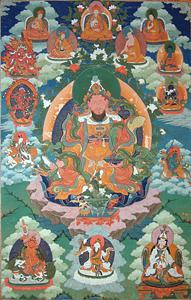January 8, 2010
AMHERST, Mass.—The Mead Art Museum at Amherst College has embarked on an ambitious project to conserve six Tibetan tangkas, or cloth paintings of Buddhist deities mounted on silk scrolls. The project will eventually allow the long-hidden treasures—whose fragile condition has rendered them virtually inaccessible to scholars and other museum visitors for more than half a century—to be handled safely, studied and displayed, said Mead Director and Chief Curator Elizabeth Barker.
 Buddha and Other Deities, one of |
“Given the deep engagement of faculty and students with the Mead’s collections and the broad interest in Buddhism and Tibetan culture in this part of Western Massachusetts, Amherst’s tangkas, once conserved, promise to become prominent subjects for scholarly research, college and K-12 teaching and exhibitions of widespread popular appeal,” she said. “We are thrilled to be able to restore these wonderful pieces to their former grandeur and share them with all of the residents of the Pioneer Valley.”
To that end, the Mead recently received a grant of $40,000 from the E. Rhodes and Leona B. Carpenter Foundation. The funding will enable the museum to clean the tangkas lightly, stabilize their painted surfaces and/or reinforce their fabric supports.
The Mead actually holds a total of 17 tangkas: 14 from Tibet and one each from Korea, China and India. Vibrantly colored, richly patterned and large (ranging in height from 4 to 9 feet), they would serve as excellent study pieces for art, history, religion or other academic courses or as the subjects of an exhibition. All, however, are too fragile to be presented safely to classes or installed in museum displays, said Barker. “The six we selected for conservation represent the most significant tangkas,” she said, adding that the museum is seeking assistance from other funding sources to support conservation of the remaining 11. “They provide a wonderful range of examples for teaching and enough depth for a compelling exhibition.”
Barker explained that the six tangkas come from the core gift at the heart of Amherst’s Tibetan art collection: 10 18th-century tangkas from the Tengyeling (or Tengye Ling) monastery in Lhasa, Tibet, donated in 1952 by Thyrza Field Hamilton, widow of George L. Hamilton, a member of the college’s Class of 1893.
The tangkas would have functioned as religious icons used by the Tengyeling monks in meditation, education, celebration and prayer, Barker noted. Commissioned by the monastery’s powerful religious leaders (who would have specified the paintings’ subjects), they would have been displayed in groups, sometimes numbering more than 100 in a single room. Their detailed landscape backgrounds and depictions of deities posed as warriors characterize innovations of the 18th century, although the tangkas’ essential iconography represents a continuation of a then-1,000-year-old tradition.
When they were donated to the Mead in 1952, the tangkas became some of the first works of Asian art to enter Amherst’s collections. “Now, as Buddhism, Tibetan culture and Chinese history have risen to prominence both as academic subjects and as matters of popular interest, the Mead’s tangkas have the potential to play a central role in their modern American home,” said Barker, adding that the Five Colleges offer a wide selection of courses and oversee a successful academic exchange with the Central Institute of Higher Tibetan Studies at Deemed University and the Institute of Buddhist Dialectics in India. “We hope participating faculty, researchers and others seize on the teaching potential of these wonderful artworks.” Pending the paintings’ conservation treatment, she said, the Mead plans to invite these faculty members to participate in an intensive course development seminar about the tangkas (for which Andrew W. Mellon Foundation funding has already been secured), tentatively scheduled for June 2011.
Interest in Tibetan culture in the Western Massachusetts area extends beyond the Five Colleges, of course. The Shang Shung International Institute for Tibetan Studies, which presents and teaches traditional Tibetan medicine and arts, has its U.S. campus in nearby Conway, Mass., just 13 miles from Amherst. And more than 100 Tibetan refugees have joined the community following Amherst’s designation as a resettlement area in 1990.
“The presence of our Tibetan neighbors, which reminds us daily of the challenges posed to Tibetan culture by that region’s occupation, has lent fresh urgency to our desire to conserve the paintings from Tengyeling entrusted to our care,” said Barker. “The Mead is looking forward to finding meaningful ways to engage our region’s active Tibetan Diaspora and students of its culture in programs involving Amherst’s tangkas.”
The Mead Art Museum houses the art collection of Amherst College, totaling more than 16,000 works. An accredited member of the American Association of Museums, the Mead participates in Museums10, a regional cultural collaboration. During the academic term, the Mead Art Museum is open Tuesday through Sunday from 9 a.m. to midnight and from 9 a.m. to 5 p.m. Friday and Saturday. For more information, please visit the museum’s Web site, www.amherst.edu/museums/mead, or call 413/542-2335.
###